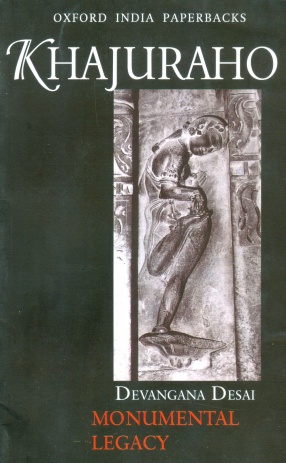Because of undue association with erotic sculpture, Khajuraho’s significant contribution to the religious art of the country is hardly noticed. This medieval religious town of central India, now a lovely village, preserves an important group of temples which represents the Indian temple in its highly evolved form, both architecturally and conceptually. While the architectural survey of the temples is done by scholars, the present work is an iconological and interpretative study of images and their contextual significance. The book offers a closer view of the divinities and their configurations, particularly in the major Hindu temples of Khajuraho. It concentrates on the iconic schemes and patheons of two magnificent temples, one a rare preserved shrine of Vaikuntha-Vishnu and the other dedicated to Siva. It highlights the important cult of the Yoginis and the syncretic role of Surya in Khajuraho’s pantheon. In the process of viewing the temple as a whole and its images within a well-integrated scheme, several earlier non-specified images could be seen in their proper context and for the first time identified and interpreted. The images of planetary divinities on the podium around the Lakshmana temple, or the Sveta-dvipa scene (Back Cover) are some such new interpretations offered in the book. Questioning the acclaimed hypothesis of the outlandish Kapalika sect as influencing the art of Khajuraho, the author demonstrates the prevalence of moderate tantric systems, as incorporating Puranic religion and Bhakti (devotion). She discusses various currents and undercurrents in the religious life of this town which flourished between A.D. 900 and 1150. The book presents an account of the topography of this medieval sacred centre, its patrons, the Chandella rulers, and erudite court culture. The elite’s love for double-entendre is revealed in the sculptural art as well as poetic stanzas of their inscriptions on temples. The language of puns and enigma (sandhya-bhasha helps us in understanding the significance of erotic sculptures which apparently are sensual figures but actually conceal a deeper symbolism.
The Religious Imagery of Khajuraho
$81.00
$90.00
In stock
Free & Quick Delivery Worldwide
All orders amounting to US$ 50 or more qualify for Free Delivery Worldwide. For orders less than US$ 50, we offer Standard Delivery at $14 per book.
ABOUT THE AUTHOR Devangana Desai
Dr. Devangana Desai was born in 1937 in Bombay. An academic training both in Philosophy and Sociology roused in her a keen interest in the Sociology of Art and Religion. Her Ph.D. dissertation submitted in 1970 to the University of Bombay forms the basis of the present book. She has to her credit a large number of papers on Ancient Indian Terracottas, Temple Art and Architecture, and Ramayana scenes in Indian sculpture. Dr. Desai was awarded the Silver Medal of the Asiatic Society of Bombay (1977) for her contribution to oriental research. She received the Homi Bhabha Fellowship in 1978-1980 and worked on “Narration in Indian Sculpture (upto AD 1300)â€. She has participated in several national and international seminars of Art History including the “Discourses on Siva†Symposium convened by the University of Pennsylvania at Philadelphia in 1981, and the “Destiny of Man†Seminar held during the Festival of India in Britain in 1982. She was awarded the prestigious Dadabhai Naoroji Memorial Prize in 1983 for her research in Indian Art. Dr. Desai is the Editor of the Journal of the Asiatic Society of Bombay and Chairman of the Museum Society of Bombay.
reviews
0 in total
Review by Anonymous
Be the first to review “The Religious Imagery of Khajuraho” Cancel reply
You must be logged in to post a review.
Bibliographic information
Title
The Religious Imagery of Khajuraho
Author
Edition
1st ed.
Publisher
ISBN
8190018418
Length
xxx+269p., Tables; Plates; Notes; Glossary; Bibliography; Index; 29cm.
Subjects
more by Devangana Desai see more
similar bookssee more
Astronomical Observatory of Jaipur
$27.00
$30.00








There are no reviews yet.